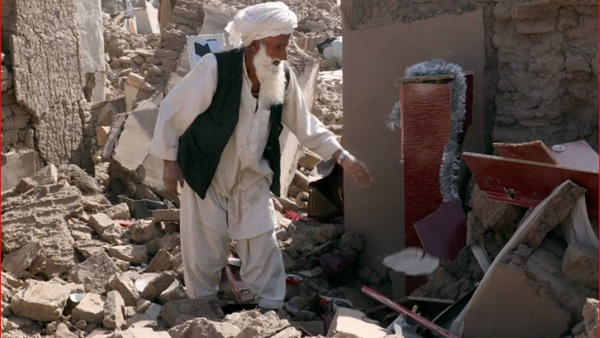Afghanistan Earthquake: Can the Taliban Control the Situation?

While the world remains
preoccupied with turbulent political events both east and west, a devastating
earthquake of 6.4 magnitude on the Richter scale struck the Afghan region of
Herat. This catastrophe led to the disappearance of entire villages,
highlighting the country's severe resource constraints. The presence of the
Taliban government, engrossed in its internal affairs, and their inability to
provide appropriate humanitarian aid during natural disasters further
exacerbates the situation.
Herat Earthquake
On the morning of October 7th,
Afghan citizens awoke to a new humanitarian disaster. A powerful earthquake,
measuring 6.4 on the Richter scale, struck the Herat region. Preliminary
estimates suggest that the number of casualties exceeded two thousand dead and
hundreds of injured. The United States Geological Survey confirmed the
earthquake's epicenter, situated approximately 30 kilometers north of Herat
city.
The American Seismological Center
reported another earthquake of the same magnitude in the region on the
following Wednesday, raising the death toll to 2,025. The United Nations
disclosed on October 12th that over 90% of the earthquake's victims were women
and children.
UNICEF in Herat further
emphasized that women and children constituted the majority of casualties in
the initial earthquake, accompanied by another 6.4 magnitude earthquake, resulting
in the engulfing of entire villages and the collapse of adobe homes. UNICEF
noted that these earthquakes caused the destruction of numerous schools,
clinics, and rural facilities.
The Afghan Red Crescent Society
announced the destruction of 12 villages in Herat province, including Zenda Jan
and Goryan. Zabihullah Mujahid, the Taliban government's spokesperson, stated
that the earthquake was followed by eight powerful aftershocks, causing the
complete destruction of 1,320 houses.
The World Health Organization
reported the destruction of over 600 houses, with some partially damaged, in at
least 12 villages near the Iranian border in Herat province. In total, 4,200
individuals were affected in one way or another by the earthquake.
Taliban's Inadequacy
Afghanistan is continually
subjected to intermittent earthquakes due to its location within the seismic
belt. While the spokesperson for the Ministry of Natural Disasters, Molavi
Janan Sayeq, announced ongoing rescue and relief efforts to find survivors
beneath the rubble, supply the necessary tents for the affected, and attempt to
deliver medical aid, food, and drinking water, it has surpassed the
capabilities of the interim government. Therefore, international humanitarian
organizations must be called upon for assistance.
Mohammad Abdul Razzaq, an expert
in Asian affairs, stated in an exclusive interview with "Al Marja"
that Afghanistan has suffered from long-standing economic problems that have
led to widespread poverty. Most villages rely primarily on primitive building
materials, such as adobe, which cannot withstand natural disasters like
earthquakes, floods, and heavy rainfall. This increases the number of victims
in such events.
He pointed out that the Taliban
movement has inherited this longstanding problem and is indeed powerless in the
face of it. They have previously issued appeals to humanitarian organizations
during similar events, including the first earthquake that struck the country
after they seized power. At that time, they acknowledged their helplessness in
the face of the disaster.
Moreover, the current situation
with the Taliban is deteriorating. Their interactions with international
organizations and their reluctance to cooperate lead to numerous problems,
hindering these organizations from functioning effectively in such
circumstances, exacerbating the suffering of the Afghan people.
Expanding the discussion
The earthquake in Herat sheds
light on the ongoing challenges faced by Afghanistan and its people. With the
Taliban in power, the country's difficulties have become even more pronounced.
The seismic vulnerability of the region is just one of the many issues that
Afghanistan must contend with.
It's crucial to understand that
the vulnerability to earthquakes in Afghanistan is not a recent development.
The country lies on the boundary of the Indian and Eurasian tectonic plates,
making it highly susceptible to seismic activity. Over the years, Afghanistan
has experienced several devastating earthquakes, and its infrastructure is
ill-prepared to withstand such natural disasters.
The situation becomes even more
dire when we consider the state of the country's buildings and homes. Many of
the structures are constructed with substandard materials, making them
particularly susceptible to damage during earthquakes. The lack of proper
construction standards and building codes only exacerbates the problem.
One of the significant challenges
in addressing this issue is the current political climate. The Taliban
government's reluctance to collaborate with international organizations and its
strained relationships with foreign governments hinder the efforts to provide
timely and effective relief. This not only affects the earthquake response but
also exacerbates the overall humanitarian crisis in Afghanistan.
Efforts to mitigate the impact of
earthquakes in Afghanistan require a multi-pronged approach. Firstly, there is
a need for improved building standards and regulations to ensure that
structures are earthquake-resistant. This includes not only new construction
but also the retrofitting of existing buildings to meet safety standards.
Secondly, the international
community must play a more significant role in disaster response and relief
efforts. The earthquake in Herat serves as a stark reminder of the importance
of humanitarian aid and support, especially in conflict-affected regions.
Moreover, Afghanistan needs to
invest in disaster preparedness and response mechanisms. This includes training
emergency responders, establishing early warning systems, and stockpiling
essential relief supplies.
The earthquake in Herat
highlights the urgency of addressing the country's vulnerabilities to seismic
activity. It also underscores the need for a coordinated international
response, even in challenging political contexts. The Afghan people deserve
assistance and relief, and it is incumbent upon the global community to ensure
that they receive the help they need during these difficult times.







